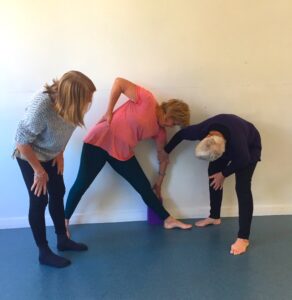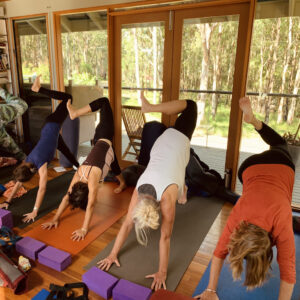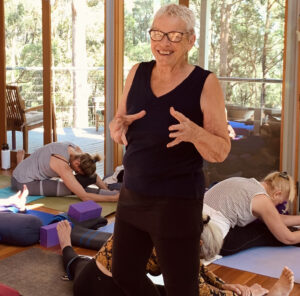Mentoring Program for Practitioners and Teachers of Yoga
Are you interested to expand your knowledge of yoga practice or teaching, or finding it a challenge to take your teaching to the next level?

I am now offering a comprehensive 6–month mentoring program comprising 12 sessions of 1.5 hours, for a total of 18 hours.
These hours can count as Professional Development hours.
I have been teaching yoga for over 35 years, initially as a trained Iyengar teacher, becoming a certified Anusara® teacher in 2009.
I am now a Registered Level 3 teacher with Yoga Australia.
I have been fortunate to receive extensive instruction in anatomy, yoga philosophy, yoga as a therapeutic tool, and meditation in addition to asana teacher training.
Since then, I have guided both teachers and those who simply wish to expand their practice, through teacher trainings, Anusara Immersions, workshops, retreats and personal sessions.
I have found the personal 1:1 sessions to be extraordinarily productive for those participating.
They create an invaluable space to unpack the challenges and uncertainties faced by many on the yoga journey, and offer an exclusive opportunity to find appropriate ways to address the challenges in a supportive environment.
All of this in an openhearted and respectful relationship.
I can offer experienced guidance in any or all of the following subjects:
- Teaching physical alignment in asana practice
- The philosophy of non-dual Tantra and how it fits in our practice and in our lives
- What is karma, and why it matters for our practice
- Developing intentions for class practices, or practicing with an intention
- How to construct class sequences for different circumstances
- Language to inspire your students
- How to create variations of poses to suit all bodies
- Anatomy and therapeutic applications of asanas
- Subtle body anatomy
- How to teach meditation and pranayma from a non-dual perspective

Teaching physical alignment in asana practice
Why do we need an alignment structure for asana practice?
Our bodies have an inner subtle energy pattern that changes from moment to moment, depending on a variety of factors, including our age.
This energetic blueprint ‘broadcasts’ what the true Essence of embodied life is all about: freedom, joy, beauty and love.
When we align the physical body, it’s like aligning an antenna to effectively pick up the signals from the inner, energetic Essence so that we can align to our highest possibility at any moment.
Good alignment also has another important function: as prana moves through the subtle energy pathways, it can release the subtle deposits we call karma, or conditioning.
If we don’t address physical alignment in asana practice, our old patterns will simply reassert themselves in whatever we create with our bodies. To shift the karmic deposits, we need good alignment for prana to move freely throughout the subtle body.
The philosophy of non-dual Tantra and how it fits in our practice and in our lives
There is a common belief in the yoga world that hatha yoga originated with Patañjali’s Yoga Sūtras (compiled 325 – 425CE). This is not so.
As practitioners and teachers it is essential that we are very clear about the history of yoga, and which tradition hatha yoga arose from: 600 years after Patañjali’s Sūtras.
Patañjali’s yoga is one of dualism, whereby each sentient being has a soul but is not part of one ever-arching entity.
Tantra’s view is non-dual. Our individual nature is an expression of Universal Consciousness – as is all materiality, including our bodies. Hence union with Supreme Consciousness is to be found in this world, in these bodies, through our practices.
In this segment I will teach you how we can understand the nature of the Universal and it’s powers and attributes, how the process of individuation comes about, and how we can practice to recognise that in our individuality, we are One.
I can also show you how to find and understand the jewels of Patañjali’s Yoga Sūtras – not the second chapter of the 8 limbs, but the first chapter that deals with the mind and meditation.
Karma and how it relates to our practice
We often hear about Karma as being a kind of universal retribution system, but nothing could be further from the truth. It is actually our internal mechanism of conditioning, shaped by our perceptions and our responses to those perceptions. Yoga in its original form and practice was a response to that conditioning, but even as we practice modern postural yoga, we can still respond to the karmic conditioning in a way that helps us to recover our innate freedom. I will show you how karmic seeds develop and what we can do about them.
Developing intentions for class practices, or practicing with an intention
 Asanas are far more than a physical posture; they are a stance of our inner being.
Asanas are far more than a physical posture; they are a stance of our inner being.
As yoga practitioners and teachers you can shift asanas from a primarily physical practice to one of expanding awareness, by using an intention in conjunction with alignment instructions.
This becomes the inner alignment.
I will show you how to choose an intention to reflect both daily life and the Tantric understanding or our place in this world, and how to weave its magic through the practice in a way that allows each student to become more reflective and discerning: more self-aware.
Through this process, the unique experience of an individual can move from contraction to expansion.
If we’re sitting in the right place internally, we’re in the asana.
How to construct class sequences for different circumstances

A sequence is a systematic way to teach or practice asana.
The beginning of a well-thought-out sequence is not too technical but gives more attitudinal instruction to create inner alignment.
It often builds to an apex pose, and then has a cool-down period before śavāsana – an essential element of any sequence.
But while not all sequences have an apex pose, there needs to be coherence to the practice, even for restorative classes.
I will show you how to build sequences in a logical way that brings opening, vitality and stability to your students.
Language to inspire your students
There are many hallmarks of good voice and use of language as a teacher.
It’s important to be an authentic teacher, and there are ways in which the quality of your voice can inspire students to reach for a pose they might find challenging, or invite them to become more reflective or introspective.
The language we use is also critical to how a student responds to instructions.
I will teach you how to instruct with the breath; how to use plain language; how to link instructions and describe transitions; active and passive language and much more.
And importantly, I’ll show you how to connect with the heart of the student.
How to create variations of poses to suit all bodies
 An asana class is not a one-size-fits-all series of poses.
An asana class is not a one-size-fits-all series of poses.
In this time of increased practice from online classes it is important that you understand how to change a pose from one that is potentially injurious to one that your body can work with effectively.
Striving too hard can take us out of alignment, and move us away from the fundamental Essence of our being.
The use of props is a highly productive and supportive way to adapt poses for limitations or injury. Sometimes we might need a chair, or simply substitute one pose for another, similar asana.
In this segment I will show you how to adapt any asana of your choosing.
Anatomy and therapeutic applications of asanas
A new teacher in a yoga class can only ever work in a general, foundational way with balancing the actions of any pose – there’s no time for anything else.
As you become more knowledgeable about anatomy and more aware of imbalances at a glance, you can begin to address individual imbalances and misalignments in the class situation.
This segment will teach you about major misalignments in the shoulders, upper and lower back areas, knees and hips, and show you how to address these in a class situation.
I’ll go over the anatomy of these areas and how the parts relate to the whole structure, anatomically and energetically.
As a result, you will become more confident about giving an individual in class something different to do whilst still addressing the majority of students.
Subtle body anatomy
 This brief area of study will clarify the structures of the subtle body, which are too often based on misunderstandings.
This brief area of study will clarify the structures of the subtle body, which are too often based on misunderstandings.
Many of these misunderstandings have arisen from western interpretations of material that has been incorrectly translated from the original Sanskrit.
We are fortunate that in recent times Sanskrit scholarship has reached a very high level, resulting in a far more advanced understanding of how the yoga masters of the past practiced with subtle body energy.
How to teach meditation and pranayama from a non-dual perspective
Tantra has hundreds of meditation techniques, and for each individual one or another works better as a way to turn inside.
I have perhaps six or eight I use in the class situation, and I’m happy to share them, but more importantly I will share ways in which you can teach the process of meditation to students who don’t yet have a practice.
Mantra meditation is included in this segment.
Pranayama is a significant part of any hatha yoga practice. Pranayama is about disciplining the breath. But it is with the attitude that we support and serve Śakti by lengthening, directing and regulating the breath, navigating the currents within the sea of prana – which is the sea of consciousness. We are no more separate from this sea than waves are separate from the ocean, so when we practice pranayama, we begin to understand something about who we are.
I’m here to take you on a comprehensive and expansive journey of exploration.
An exploration of your practice, or your teaching, or both.
The clearer you become in understanding what yoga practice really is, what tradition it comes from and the most effective ways to communicate how to practice it, the more effortless it becomes.
You will be able to seat yourself at the centre of this vast field of knowledge, and draw upon its scholarship for the benefit of both yourself and your students.

A mentor is someone you can trust as an experienced and empathic advisor.
In the world of yoga practice and teaching, a relationship such as this can be one of the most rewarding and satisfying relationships we can develop on the path of yoga.
I feel confident in creating a safe space for these sessions, and embodying the ethical principles required of a yoga teacher and mentor.
If you take just one thing away from this program, it will be of expanded awareness as you become more discerning and increasingly familiar with this extraordinarily extensive and all-embracing material.
The outcome can only be a gift to all, for as you grow in knowledge and practice of yoga, all will benefit.
Investment: AUD$2,200
Booking: Email me cduf47@gmail.com to discuss what you would like to take away from this program, and the segments that most interest you.
Payment details will follow.
“I found Christine’s course very inspiring. I have looked over my notes many times since we finished and I am drawing from them more and more inspiration with ideas I can share in my own classes. The 1:1 session was so helpful to me and, in fact, this is what I loved most. It can feel very lonely when you are working on your own, so having someone to bounce ideas off is so valuable. “
Nikki, Queensland
“Christine is a wonderful, warm teacher and mentor. My own practice deepened and my confidence in teaching improved so much under her skilled guidance, knowledge, patience and kindness. Great teachers inspire you to be your best. Christine is amazing and I highly recommend her mentoring program.”
Kim, Forster, NSW
“I have been incredibly fortunate to have worked with Christine as my mentor – this has meant I have had many opportunities to reach out to her for assistance as I have developed my skill and confidence as a teacher.
She has so much in-depth knowledge of anatomy, philosophy and working therapeutically with asanas, and I can draw upon that knowledge.
And if she doesn’t know the answer, she readily gives time to work through the problem with me.
I wouldn’t hesitate in recommending Christine as a mentor.”
Justine, Bulahdelah, NSW
